10 Chinese American Dishes That Aren't Commonly Eaten In China
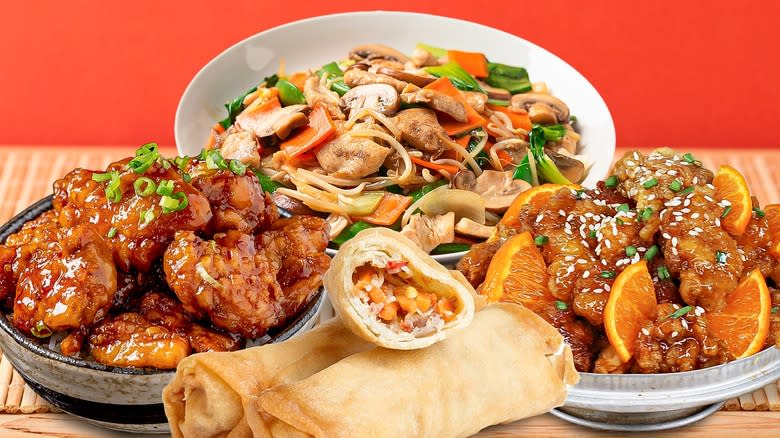
Chinese dishes are some of the world's heartiest culinary delights. Just slapping the "Chinese" label, though, wouldn't be accurate, as it's actually an umbrella term encompassing different regional categories. Guangdong/Cantonese cuisine is known for its mild and sweet sauces and seasonings. By contrast, Sichuan creations are particularly spicy and garlicky. Jiangsu dishes are more subtle and focus on artistic presentation, while Zhejiang food is seafood centric. Fujian/Min cuisine experiments with sweet and sour, whereas Hunan food is noted for sautes and stir-fries. As for Anhui dishes, they mostly use wild plants, and the Shandong region is praised for its braising technique. No matter the area, though, the Chinese kitchen typically favors the same key ingredients, which include ginger, soy sauce, rice wine, and sesame oil.
In Western countries, some of the most famous Chinese appetizers and dishes have been adapted to accommodate local palates and incorporate widely available ingredients. Such is the case with Chinese American cuisine, which was popularized by Chinese immigrants in the mid-19th century and is now recognized as a standalone category in its own right.
From takeout to all-you-can-eat buffets, Chinese American food keeps reinventing itself while retaining essential traditional flavors. It's so delicious, wide-ranging, and comforting that there are currently over 24,000 Chinese restaurant businesses in the U.S., with the highest number concentrated in California, New York, and Texas. That said, are you aware that the following popular Chinese menu items in America aren't commonly consumed in China or have strayed from the original recipes?
Read more: Styles Of Regional BBQ In The US
Egg Rolls
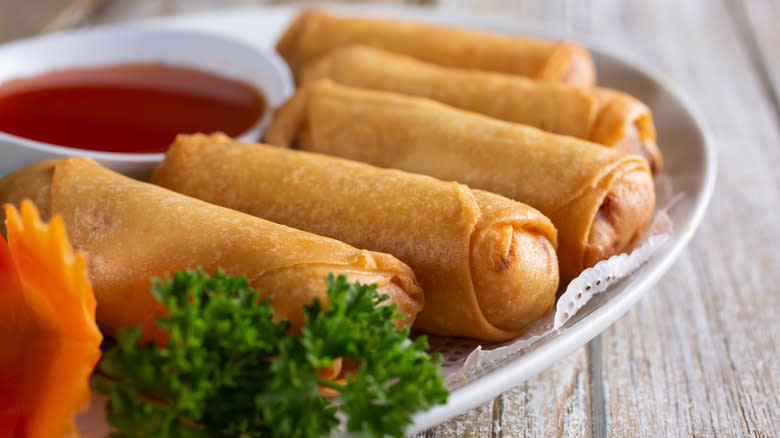
Some people might still confuse egg rolls with spring rolls, or use the terms interchangeably, so here is a quick refresher. Whether wrapped in translucent rice paper or thin, golden-fried wheat dough, spring rolls can be served hot or cold and are available in many Asian countries, like China, Thailand, and Vietnam. They date back to the Jin Dynasty (A.D. 265-420) and got their name from being widely consumed at festivals held in the spring. Fillings usually include tofu, shrimp, or meat and fresh vegetables.
As for egg roll wrappers, they're made with eggs, wheat flour, and water, which give them a rougher and thicker texture. They're predominantly deep-fried and contain either pork, shrimp, or ground meat and cooked cabbage (and other steamed veggies). More importantly, they're always served warm. As to whom they owe their existence, there are two potential candidates. A Chinese immigrant named Henry Low claimed to be the creator after he began perfecting recipes at a Chinatown restaurant in New York City in 1928. However, others believe it was Lum Fong, who started running a popular restaurant in NYC three years prior.
Either way, egg rolls are now a staple in Chinese American cuisine as a crunchy prelude to the main dish. You can easily make it at home, too. Check out this delicious pork and shrimp egg roll recipe; it's served with so-called duck sauce (another American creation!), which actually only contains peach or apricot preserves, soy sauce, sugar, and apple cider vinegar.
Beef With Broccoli
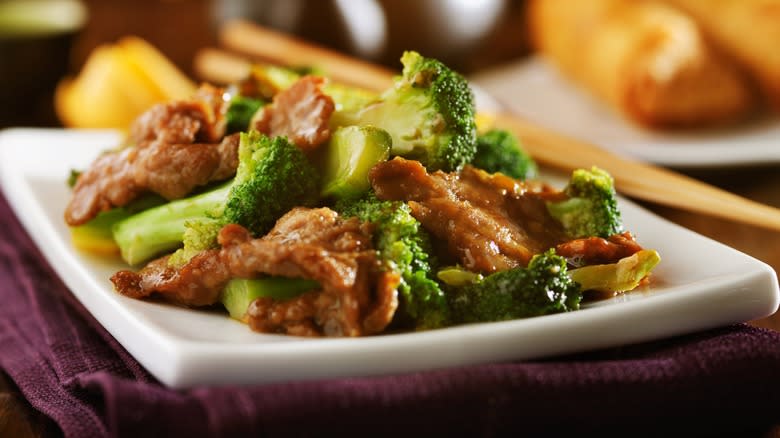
The ever-so-popular beef with broccoli dish consists of thinly sliced pieces of steak that are stir-fried with broccoli florets and tossed in soy sauce, oyster sauce, and cornstarch, among other ingredients. It is thought to have been popularized in the U.S. by Chinese immigrants in the 1950s, if not earlier. You likely won't find that Chinese American dish canon in China, though, at least not in this form and flavor. For starters, per McKinsey & Company, it's mostly pork that dominates the kitchen in China, followed by chicken, then beef and other meats. What's more, this particular type of broccoli doesn't grow in China. The closest ingredient that is typically served with beef there is gai lan, a kale-like vegetable with thick stems and shiny blue-green leaves.
Meanwhile, try this hearty, takeout-style beef and broccoli recipe. You could always use frozen broccoli, then add brown sugar, mirin, garlic, ginger, and black pepper to the aforementioned sauce. Finally, serve the dish with steamed white rice, sprinkled with toasted sesame seeds.
General Tso's Chicken
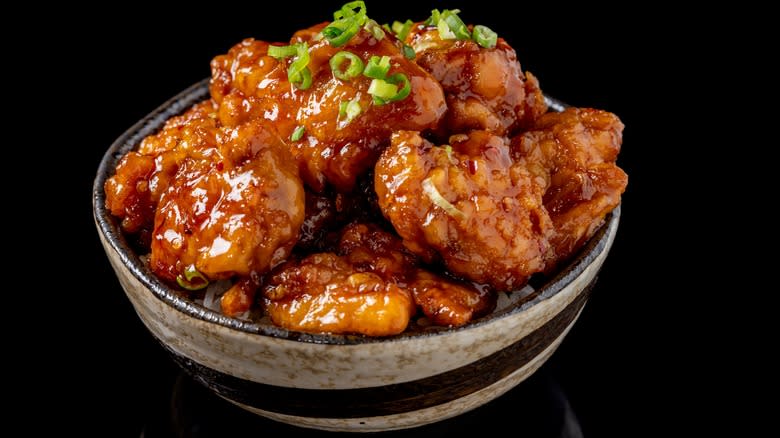
With its bold combination of tangy, sweet, and spicy notes, General Tso's chicken is another commonly ordered item in Chinese American restaurants. It typically consists of bits of boneless chicken thighs marinated in egg white, dark soy sauce, and Shaoxing wine. They're then coated in cornstarch, deep-fried, and tossed in a thick mixture that usually includes dark and light soy sauce, brown sugar, hoisin sauce, oyster sauce, sesame oil, and rice wine vinegar.
Still, chances are you won't be able to order this particular item while on a trip to China. And who exactly is this General Tso, anyway? This dish is believed to have been named after an actual 19th-century general from the Hunan province. It was popularized in Taiwan in the 1950s by a Hunanese immigrant chef named Peng Chang-kuei. Initially, as he told The New York Times decades later, the recipe called for a heavier, saltier, spicier, and sourer sauce. As journalist and documentarian Jennifer 8. Lee noted in HuffPost, the chicken also wasn't deep-fried. When Peng opened a New York City restaurant in the 1970s, he tweaked the Hunanese recipe and made it sweeter for American palates.
However, as for the current beloved stateside version, it was allegedly inspired by Peng's and developed by another NYC chef called Tsung Ting Wang. It consists of a crispier and thicker batter, as well as a predominantly sweet sauce.
Orange Chicken
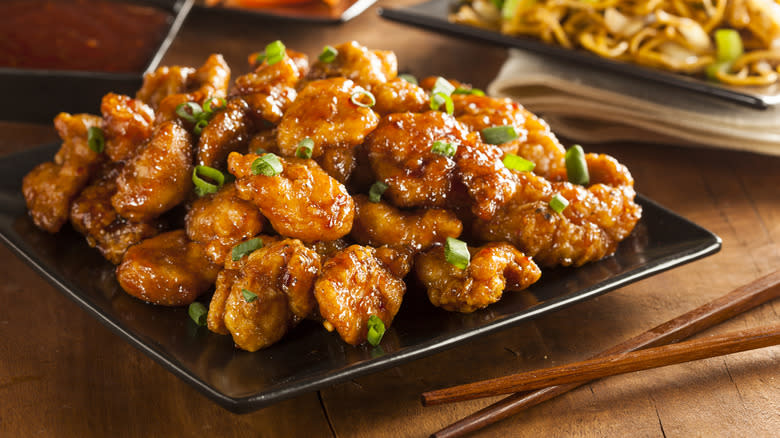
An orange chicken stir-fry is usually made with boneless chicken breast cubes that are flavored with garlic, ginger, rice wine vinegar, soy sauce, sugar, chili flakes, and orange juice and zest. The chicken is then sprinkled with toasted sesame seeds and/or scallions and served with steamed rice. Panda Express, the renowned Chinese American fast food chain, is credited with the invention of this particular dish. According to the Willson Center Digital Humanities Lab's exhibit on the restaurant, it was first introduced back in 1987. Thanks to its tantalizing signature sauce, this sweet, tangy, and slightly spicy dish is currently the brand's most popular menu item, and it has inspired other venues to develop their own variations.
It's not an entirely novel idea, though, but rather a spin on a similar dish presented in America by Chinese immigrants in the 1800s. The chicken wasn't served breaded at the time. Meanwhile, the sauce featured ingredients like leftover citrus peels (usually orange or lemon), mixed with soy sauce, chili flakes, and garlic. Despite the similar citrusy factor, it was certainly not as strong, sweet, or thick as it is in its current popular form. So, good luck trying to order the exact same thing in China.
Crab Rangoon
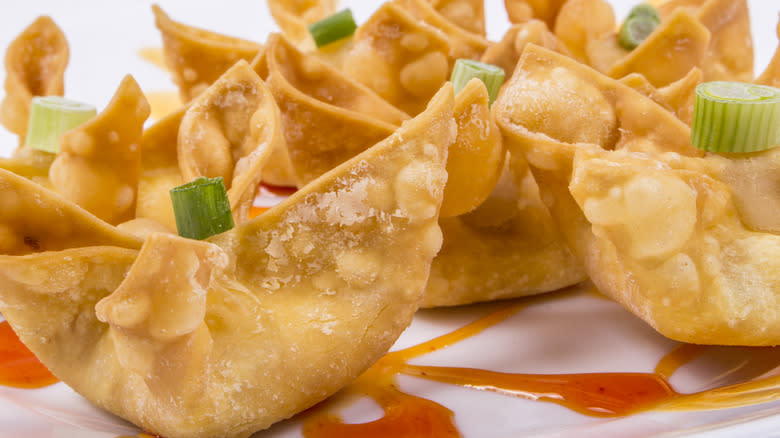
Crab rangoon, also known as crab puffs, cheese wontons, and cream cheese rangoons, are crisp dumpling appetizers that come in various shapes. These are all the rage in Chinese, Thai, and Japanese joints in the U.S. Here is how to make crab rangoon at home. Just combine shredded imitation crab (or real crab, for that matter), cream cheese, Worcestershire sauce, garlic, sugar, and scallions. Fill some wanton wrappers with this mixture and fry them in your vegetable oil of choice until golden brown. It's that simple. And while some people prefer serving them with sweet and sour sauce, others enjoy dipping them in chili soy sauce.
These exact scrumptious and crispy wontons aren't commonly found in China, though. It's believed that Victor Bergeron, the founder of Trader Vic's — the globally famed Polynesian-themed restaurants — invented crab rangoon in the U.S. back in the 1950s. Even though other fried wontons were introduced in the U.S. about two decades earlier, the crab rangoon variety was apparently first highlighted in the San Francisco Chronicle in May 1950, according to the Sampan newspaper.
Kung Pao Chicken
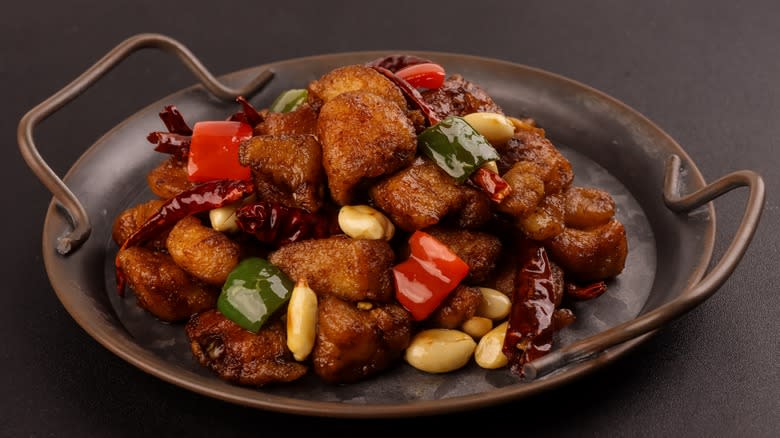
Meaning "palace guardian" and sometimes spelled gong bao or kung po, kung pao chicken comprises stir-fried chicken, vegetables, peppers, and peanuts, served on a bed of steamed rice. It is said to have gotten its name from Ding Baozhen, a prominent Qing Dynasty government figure in the Sichuan or Szechuan province during the 19th century. The original, authentic dish, though, contains a key ingredient from that region that's usually missing from the Americanized version: a copious amount of the fragrant, elongated, and slim Sichuan chili peppers. They're a great source of vitamins A and C that likely improve immunity and vision and combat inflammation.
As for the American, cornstarch-glossed version, it includes soy sauce, rice vinegar, and sugar. It also incorporates any type of peppercorns, including sweet bell peppers, and certainly in fewer quantities than the initially required amount. The end result is a subtle combination of sweet, savory, nutty, and mildly spicy flavors, and that is exactly what makes it so appealing. But how come the westernized version differs from the original? It's likely because the U.S. banned importing Sichuan peppers in 1968. By the time the ban ended in 2005, local palates had already grown accustomed to the reinvented recipe that sometimes even substitutes chicken with shrimp.
Fancying a meat-free kung pao? How about swapping the chicken with cauliflower, tofu, or chickpeas? There are several vegetarian or vegan variations you could experiment with when it comes to that versatile, colorful, and filling dish.
Chop Suey
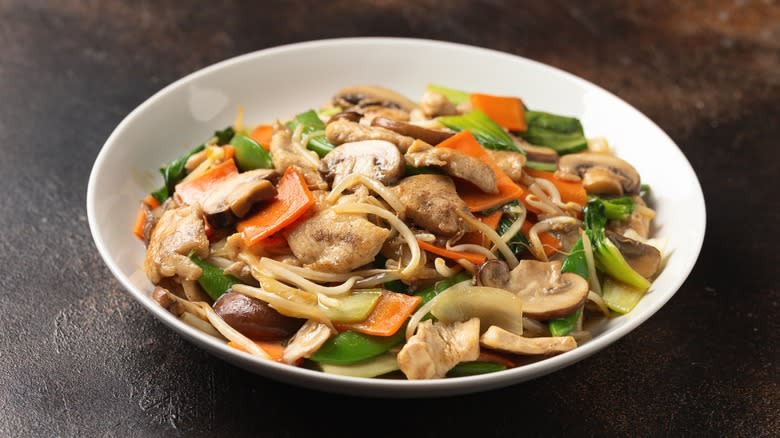
Consisting of eggs, meat, and vegetables, chop suey was likely popularized on the East Coast in 1896, according to Professor John Jung's article "The Sour Side of Chinese Restaurants," and it's technically not Chinese, either. It apparently is inspired by a meat, celery, and bean sprout stew served in Southern China, called zaptsui in Cantonese and zacui in Mandarin (this roughly translates into "random mixture"). In 1912, the San Francisco Call (via Charles W. Hayford's "Who's Afraid of Chop Suey?") published that, "There is no chop suey in China. A traveler in the East made this discovery. He tried to find chop suey in Peking. Later in Hong Kong. At one cosmopolitan place in Shanghai he found a sign, 'American style cooking. Chop Suey.'"
The dish quickly grew in popularity stateside. Chop suey was not only enjoyed at socialite functions in the following decade, but this highly regarded dish was also published in lifestyle outlets targeted toward women to make from the comfort of their own kitchen. Even U.S. Presidents Lyndon B. Johnson, Calvin Coolidge, and Dwight D. Eisenhower were said to have enjoyed a chop suey every now and then.
As for the so-called American chop suey, it's an entirely different spin altogether. This dish refers to a macaroni, ground beef, onion, tomato, and cheese casserole.
Sweet And Sour Pork
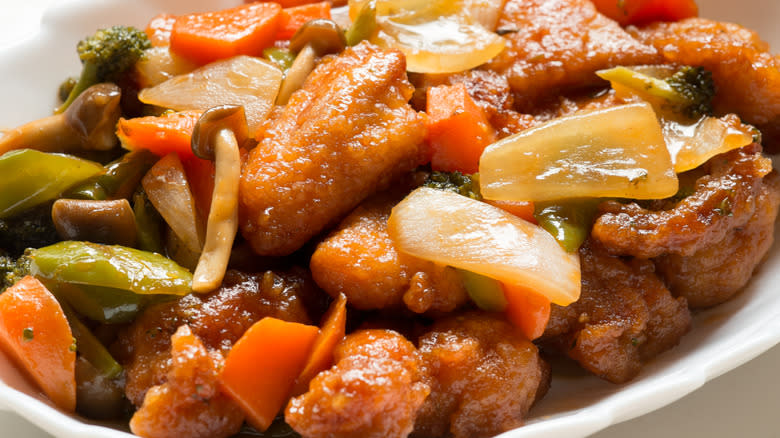
Sweet and sour pork, or gu lao rou, is yet another widely popular Chinese American staple. The star ingredient is diced garlic, soy sauce, and ginger-marinated pork. It is deep-fried twice, resulting in a satisfying and filling meat that is crispy and crunchy on the outside and tender and juicy on the inside. The pork is then drenched in a mixture of ketchup, sugar, soy sauce, and white vinegar, and typically tossed with chopped pineapple, bell peppers, carrots, and onions.
Multiple sources claim that dish traces its origins to 18th-century Chencun, in the province of Canton/Guangdong. However, initially, it was supposedly made with much less garnish (and certainly without pineapple) and with pork ribs, not shoulder bits. Chinese immigrants brought it to North America in the early 20th century and revamped it to suit local palates. They incorporated tomato sauce, and later ketchup, resulting in a much sweeter flavor and a heavier texture.
Egg Foo Young
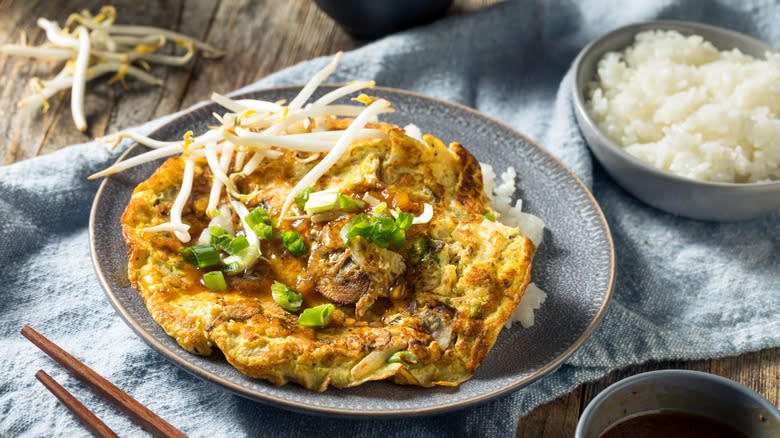
The versatile egg foo young is not only enjoyed in North America, but also in many parts of the world. It is considered one of the best egg dishes, along with Japan's chawanmushi, Brazil's quindim, and Tunisia's egg brik. Served as either a cost-effective main course or a side dish, egg foo young is essentially meant to combine and elevate leftovers. Today, it normally consists in a thick, crispy, and puffy pancake-like omelet that contains at least one protein, eggs, and various stir-fried vegetables. Typically drizzled with a thick sauce made with soy sauce, Shaoxing wine, sesame oil, oyster sauce, and cornstarch, this dish is served with steamed or fried rice and garnished with scallions.
The name itself most likely derives from the Cantonese gai fu yung, which means either "basket omelet" or "tower omelet." As for the recipe, it probably dates back to the mid-20th century. It is said that, back then, Chinese immigrants reinvented a traditional Southern Chinese omelet that was originally made with pan-fried egg slices, vegetables, and pork. Naturally, they had to include locally sourced ingredients, such as minced meet or seafood, mushrooms, bell peppers, and onions.
It's one of the easiest dishes to prepare. You could even unleash your creativity by incorporating a handful of ingredients, from carrots to bamboo shoots and bean sprouts.
Fortune Cookies

At many Chinese restaurants across the U.S., patrons are usually presented with a folded fortune cookie at the end of their meal. It's basically a crisp wafer made from sesame oil, flour, vanilla, and sugar, which they're supposed to break in order to reveal a piece of paper with an inspirational message or quote. Common sayings vary from, "An exciting opportunity lies ahead of you," to "You will receive money from an unexpected source," and "A journey of a thousand miles begins with a single step." And if you're curious as to how and when exactly those messages are inserted inside the cookies, the answer lies in the small timeframe before the freshly baked goods cool down and solidify.
But did you know that this concept didn't even originate in China, but rather in Japan? Per The New York Times, shops near Kyoto in the 1870s commonly sold tsujiura senbei, aka "fortune crackers". They were larger than the ones you're accustomed to, with ingredients including miso and sesame. Then, the Japanese immigrants who moved to Hawaii and California in the 1880s popularized the idea. And finally, per SF Heritage, it is said that a bakery in San Francisco called Benkyodo introduced the vanilla and butter flavoring and started producing the cookies in larger quantities in 1911.
Read the original article on Tasting Table.

